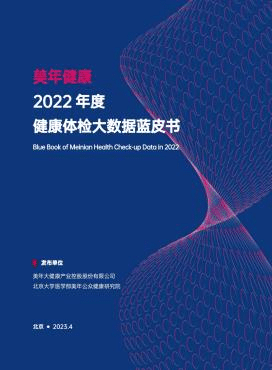“Meinian Health’s 2022 Annual Health Examination Big Data Blue Book” was released, the number of samples exceeded tens of millions, and half of the samples had overweight, lung nodules, and thyroid nodules

[ad_1]
On April 16, under the background of promoting the national strategy of building a healthy China, the first China Preventive Medicine Innovation Summit and the Meinian Health Innovation and Development Forum were held in Beijing. The meeting was guided by the China Health Management Association. Organ Function Quantification Management Branch of Management Association is the sponsor.
At the summit, Meinian Health Group and the Meinian Health Research Institute of Peking University Health Science Center jointly released the “Meinian Health 2022 Annual Health Examination Big Data Blue Book” (hereinafter referred to as the “Blue Book”). The data in the blue book comes from the 2022 Meinian Health Group The number of samples taken from the annual physical examination population is 16.47 million, covering 31 provinces, autonomous regions and municipalities across the country. The main analysis object is the labor force population. It is the first time in China that the number of samples exceeds 10 million and the geographical coverage is the most extensive. , and contains the multi-ethnic group examination data report of healthy people.
The blue book focuses on the main areas of “Healthy China”. Based on the two dimensions of disease burden and health hazards, the five major areas of cardiovascular health, endocrine health, respiratory health, digestive health, and urogenital health are selected for in-depth analysis of common diseases and abnormalities in health checkups.
The age of the blue book focuses on the “post-80s” and “post-90s”, with an average age of 42 years, of which 53.8% are males and 46.2% are females. The 25-59-year-old occupational group accounts for 82% of the included population, which objectively reflects the labor force in my country. Average fitness.
The blue book was jointly compiled by Meinian Health Group and Meinian Public Health Research Institute of Peking University Health Science Center. The research process extensively refers to international and domestic authoritative disease guidelines and expert consensus, and uses clinically recognized disease diagnosis and evaluation methods to detect common diseases and abnormalities in physical examination. The output rate is standardized and adjusted to fully ensure the accuracy and reliability of the research results.
The release ceremony was jointly launched by Xu Tao, President of Meinian Health Group, and Wang Xiaojun, President of Meinian Public Health Research Institute.

Xu Tao, President of Meinian Health Group, and Wang Xiaojun, President of Meinian Public Health Research Institute
Hu Ruomei, vice president and secretary-general of the Meinian Public Health Research Institute, interpreted the blue book. She made a comprehensive analysis of the health status and characteristics of the 2022 annual physical examination population, and at the same time focused on the detection rate of each indicator combined with important characteristics such as age, region, and gender. was sorted out in detail.

Hu Ruomei, Vice President and Secretary General of Meinian Institute of Public Health
Announced TOP5 major detection rate, half of the population has overweight, lung nodules, thyroid nodules
According to the report, the top five detection rates of abnormal physical examination results are: pulmonary nodules (54%), overweight and obesity (50%), thyroid nodules (47%), fatty liver (40%), Helicobacter pylori infection ( 33%). That is to say, half of the physical examination population in the report has overweight, lung nodules, and thyroid nodules.
In terms of geographical distribution, most chronic diseases have regional differences that are higher in the north and lower in the south. Among them, the detection rates of hypertension, carotid plaque, obesity, diabetes, and thyroid nodules showed a trend that the north was higher than the south in the whole country. However, hyperuricemia and kidney stones tend to be higher in the south than in the north. The detection rate of pulmonary nodules showed a trend that the east was higher than the midwest. The detection rates of fatty liver, advanced liver fibrosis, liver cirrhosis, and breast nodules tended to be higher in the eastern and central regions than in the western regions.
The Blue Book shows that the detection rates of hypertension, dyslipidemia, hyperuricemia, carotid plaque, obesity, overweight or obesity, diabetes, fatty liver, and kidney stones are significantly higher in men than in women. The detection rate of thyroid nodules in women is significantly higher than that in men.
The blue book shows that the detection rate of dyslipidemia items is 29%, of which the detection rate of men is 38%, and the detection rate of women is 20%. Women had the highest rate of dyslipidemia. In terms of geographical distribution, the southwest region and the northeast region are the two regions with the highest rates of dyslipidemia in the country.
The detection rate of high uric acid items is 20%, of which the detection rate of men is 35%, and the detection rate of women is 4%. The detection rate of men is significantly higher than that of women in all age groups, especially young men. Among them, men in Southwest China, South China, and Northeast China are higher than those in other places. On average, 4 out of 10 men in Southwest China have high uric acid.
For the thyroid nodule project, the detection rate of women is slightly higher than that of men. The overall detection rate of this project is 47%, of which the detection rate of men is 40% and the detection rate of women is 54%. The national detection rate of thyroid nodules shows a trend that the north is higher than the south, and the coastal area is higher than the inland.
“Three high problems” are not uncommon, focus on “be careful”
In this report, Vice President Hu Ruomei also pointed out the “three high problems” of the physical examination population, which are high-risk factors for cardiovascular and cerebrovascular diseases that cannot be ignored. Among them, 25% of the population had high blood pressure, 29% had dyslipidemia, and 9% had diabetes , 21.9% carotid plaque.
It is worth mentioning that the blue book shows that 40% of the population has fatty liver, and middle-aged men aged 40-44 and women aged 65-69 have the highest detection rates of fatty liver in men and women, respectively. In terms of geographical distribution, the detection rate of fatty liver was the highest in Northeast China, with a detection rate of 46.2%, and the lowest detection rate in South China was 34.4%.
The detection rate of liver fibrosis and liver cirrhosis increased with age. A total of 9,512 cases of advanced liver fibrosis were detected, the detection rate of advanced liver fibrosis was 0.7%, and 1,714 cases of liver cirrhosis were detected, the detection rate of liver cirrhosis was 0.1%. Among them, liver fibrosis refers to the diffuse excessive deposition and abnormal distribution of extracellular matrix in the liver. It is the pathological repair response of the liver to chronic injury, and it is a key step in the development of various chronic liver diseases to liver cirrhosis and a factor that affects the prognosis of chronic liver diseases. important link.
For women, HPV infection and breast nodules are health threats that cannot be ignored
A total of 50,000 cases of HPV infection were detected in 437,000 female physical examination persons, and the detection rate of HPV infection was 12%. Among them, 41,700 cases were high-risk HPV infections, accounting for 82.5% of all infected persons, and the detection rate of high-risk HPV infection was 10%.
The detection rate of female HPV infection and high-risk HPV fluctuates with age, showing a double-peak trend. The two age groups with the highest detection rates are 18-24 years old and 60-64 years old. The HPV detection rate They were 19% and 14.5%, respectively, and the detection rates of high-risk HPV infection were 16.5% and 12.5%.
The detection rate of breast nodules in women is 31.5%, and the highest detection rate of breast nodules in middle-aged women aged 40-50 is 44%. At the same time, improving the detection rate of early breast cancer and timely and effective treatment are effective measures to reduce breast cancer mortality. Breast ultrasound is one of the important means of breast cancer screening.
The release of “Meinian Health 2022 Annual Health Examination Big Data Blue Book” is an attempt and effort by Meinian Health Group to fulfill corporate social responsibility as a leading enterprise in the preventive medicine industry. Provide data support, provide important references for relevant research institutions, provide data support for relevant government departments to formulate, implement or improve relevant health policies, and also provide data support for the popularization of “prevention first” and “early screening, early assessment, early Intervention” health concept, improve the public’s active health awareness, and contribute to the comprehensive improvement of residents’ health literacy.
[ad_2]
Source link

![[Love Wants Sexual Happiness Series 358]Find the culprit and overcome psychogenic erectile dysfunction. Don’t let pressure affect your sexual happiness.](https://chinathenews.com/wp-content/uploads/2024/04/171111-780x420.jpg)

![[Wanqingyi Care]My health, my rights, customized medical methods in the last stage of life](https://chinathenews.com/wp-content/uploads/2024/04/ZZ1-100-780x420.jpg)
![[Kidney Transplantation Special Topic]The survival rate of transplanted kidneys is high without dialysis treatment three times a week](https://chinathenews.com/wp-content/uploads/2024/04/1311-780x420.jpg)



